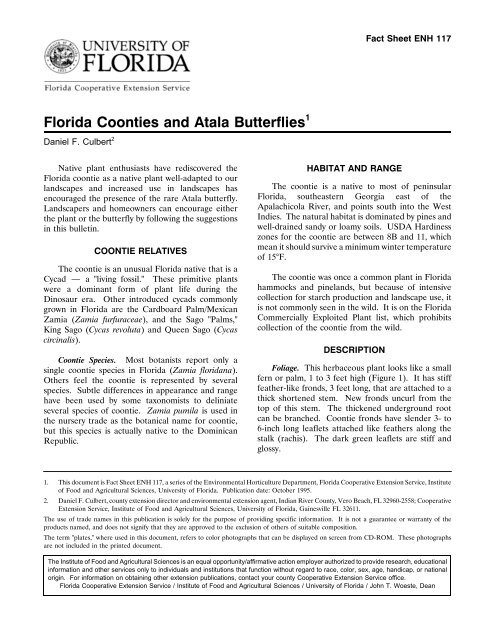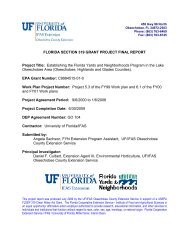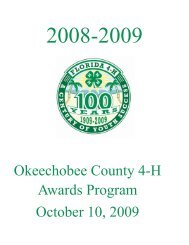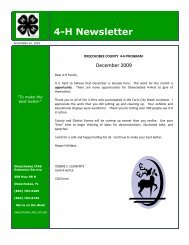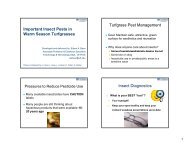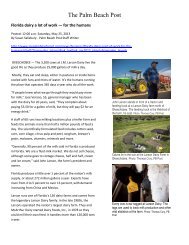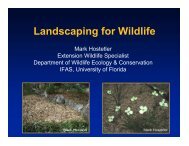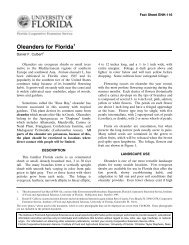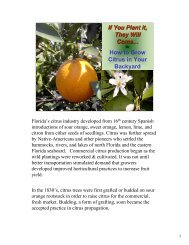Florida Coonties and Atala Butterflies - Palm and Cycad Societies of ...
Florida Coonties and Atala Butterflies - Palm and Cycad Societies of ...
Florida Coonties and Atala Butterflies - Palm and Cycad Societies of ...
Create successful ePaper yourself
Turn your PDF publications into a flip-book with our unique Google optimized e-Paper software.
Fact Sheet ENH 117<strong>Florida</strong> <strong>Coonties</strong> <strong>and</strong> <strong>Atala</strong> <strong>Butterflies</strong> 1Daniel F. Culbert 2Native plant enthusiasts have rediscovered the<strong>Florida</strong> coontie as a native plant well-adapted to ourl<strong>and</strong>scapes <strong>and</strong> increased use in l<strong>and</strong>scapes hasencouraged the presence <strong>of</strong> the rare <strong>Atala</strong> butterfly.L<strong>and</strong>scapers <strong>and</strong> homeowners can encourage eitherthe plant or the butterfly by following the suggestionsin this bulletin.COONTIE RELATIVESThe coontie is an unusual <strong>Florida</strong> native that is a<strong>Cycad</strong> — a "living fossil." These primitive plantswere a dominant form <strong>of</strong> plant life during theDinosaur era. Other introduced cycads commonlygrown in <strong>Florida</strong> are the Cardboard <strong>Palm</strong>/MexicanZamia (Zamia furfuraceae), <strong>and</strong> the Sago "<strong>Palm</strong>s,"King Sago (Cycas revoluta) <strong>and</strong> Queen Sago (Cycascircinalis).Coontie Species. Most botanists report only asingle coontie species in <strong>Florida</strong> (Zamia floridana).Others feel the coontie is represented by severalspecies. Subtle differences in appearance <strong>and</strong> rangehave been used by some taxonomists to deliniateseveral species <strong>of</strong> coontie. Zamia pumila is used inthe nursery trade as the botanical name for coontie,but this species is actually native to the DominicanRepublic.HABITAT AND RANGEThe coontie is a native to most <strong>of</strong> peninsular<strong>Florida</strong>, southeastern Georgia east <strong>of</strong> theApalachicola River, <strong>and</strong> points south into the WestIndies. The natural habitat is dominated by pines <strong>and</strong>well-drained s<strong>and</strong>y or loamy soils. USDA Hardinesszones for the coontie are between 8B <strong>and</strong> 11, whichmean it should survive a minimum winter temperature<strong>of</strong> 15°F.The coontie was once a common plant in <strong>Florida</strong>hammocks <strong>and</strong> pinel<strong>and</strong>s, but because <strong>of</strong> intensivecollection for starch production <strong>and</strong> l<strong>and</strong>scape use, itis not commonly seen in the wild. It is on the <strong>Florida</strong>Commercially Exploited Plant list, which prohibitscollection <strong>of</strong> the coontie from the wild.DESCRIPTIONFoliage. This herbaceous plant looks like a smallfern or palm, 1 to 3 feet high (Figure 1). It has stifffeather-like fronds, 3 feet long, that are attached to athick shortened stem. New fronds uncurl from thetop <strong>of</strong> this stem. The thickened underground rootcan be branched. Coontie fronds have slender 3- to6-inch long leaflets attached like feathers along thestalk (rachis). The dark green leaflets are stiff <strong>and</strong>glossy.1. This document is Fact Sheet ENH 117, a series <strong>of</strong> the Environmental Horticulture Department, <strong>Florida</strong> Cooperative Extension Service, Institute<strong>of</strong> Food <strong>and</strong> Agricultural Sciences, University <strong>of</strong> <strong>Florida</strong>. Publication date: October 1995.2. Daniel F. Culbert, county extension director <strong>and</strong> environmental extension agent, Indian River County, Vero Beach, FL 32960-2558; CooperativeExtension Service, Institute <strong>of</strong> Food <strong>and</strong> Agricultural Sciences, University <strong>of</strong> <strong>Florida</strong>, Gainesville FL 32611.The use <strong>of</strong> trade names in this publication is solely for the purpose <strong>of</strong> providing specific information. It is not a guarantee or warranty <strong>of</strong> theproducts named, <strong>and</strong> does not signify that they are approved to the exclusion <strong>of</strong> others <strong>of</strong> suitable composition.The term "plates," where used in this document, refers to color photographs that can be displayed on screen from CD-ROM. These photographsare not included in the printed document.The Institute <strong>of</strong> Food <strong>and</strong> Agricultural Sciences is an equal opportunity/affirmative action employer authorized to provide research, educationalinformation <strong>and</strong> other services only to individuals <strong>and</strong> institutions that function without regard to race, color, sex, age, h<strong>and</strong>icap, or nationalorigin. For information on obtaining other extension publications, contact your county Cooperative Extension Service <strong>of</strong>fice.<strong>Florida</strong> Cooperative Extension Service / Institute <strong>of</strong> Food <strong>and</strong> Agricultural Sciences / University <strong>of</strong> <strong>Florida</strong> / John T. Woeste, Dean
<strong>Florida</strong> <strong>Coonties</strong> <strong>and</strong> <strong>Atala</strong> <strong>Butterflies</strong> Page 3extension <strong>of</strong>fice for the latest chemical pesticiderecommendations.ATALA BUTTERFLYFigure 2. <strong>Atala</strong> butterfly <strong>and</strong> caterpillars.Soil <strong>and</strong> Fertilizer. Natural conditions for coontiesindicate a need for well drained soil. A successfulsoil-less media for container production has beensuggested as follows: one part Metro-Mix 500 (W.R.Grace Co.) or similar mix, one part sharp s<strong>and</strong>, onepart perlite, one part pine bark, plus 5 lbs. <strong>of</strong>Dolomite <strong>and</strong> 3 lbs. <strong>of</strong> Perk micronutrient per cubicyard.Blue green algae are known to associate withsurface (coralloid) roots <strong>of</strong> Zamia. They have thesymbiotic ability to take nitrogen from the air <strong>and</strong>change it into nitrogen fertilizer sources. Usingnitrate nitrogen reduces the effectiveness <strong>of</strong> thesealgae, while ammoniacal forms encourage the uptake<strong>of</strong> nitrogen into the cycads. In the wild, a soil pH <strong>of</strong>6.0 or more has been noted in locations with densehealthy plants.COONTIE PEST MANAGEMENT<strong>Coonties</strong> are well-adapted to our <strong>Florida</strong>l<strong>and</strong>scapes because they have adapted themselves tothis environment over many millions <strong>of</strong> years. Weedsare best controlled by mulching around the plants toprevent turf or other plants from competing with thisslow growing native. However, do not allow mulch tolay in contact with the crown, as this may encouragerot. Diseases have been noted in cases whereexcessive irrigation is supplied.One <strong>of</strong> the very few significant insect pestscommon to coontie is <strong>Florida</strong> Red Scale (Plate 1).Mealy bugs also are found on l<strong>and</strong>scape coonties(Plate 2). These insects will encourage thedevelopment <strong>of</strong> sooty mold (Plate 3). All <strong>of</strong> thesepests can be controlled with insecticidal soaps orother contact insecticides. Check with your countyAn occasional insect found on the coontie is thelarva <strong>of</strong> the <strong>Atala</strong> butterfly (Eumaeus atala), oncethought to be extinct (Plate 4). This insect is able towithst<strong>and</strong> the natural toxins in coonties <strong>and</strong> in turnuses the toxins accumulated in its body as a measureagainst bird predation. The combination <strong>of</strong> brilliantcoloration <strong>and</strong> toxin accumulation is calledaposematic protection.Range. The <strong>Atala</strong> has been reported from DadeCounty north into Martin County. In 1993, it wassighted in St. Lucie <strong>and</strong> Indian River counties. Theincreased presence <strong>of</strong> <strong>Atala</strong> butterflies can beattributed to the increased use <strong>of</strong> coonties in thel<strong>and</strong>scape <strong>and</strong> a series <strong>of</strong> mild winters.Description. Caterpillars, or larva, (Plate 5) areorange-red with seven pairs <strong>of</strong> yellow spots runningalong the back (dorsal side), <strong>and</strong> will reach 1.25inches long. Orange <strong>and</strong> brown pupae (chrysalises)hang from a sling under coontie leaflets, <strong>and</strong> are 1inch long.The adult butterfly (Figure 2) has a 1.5 inchwingspan, with its velvety wings roughly oval in shape.Wings are black with metallic blue spots on theunderside <strong>of</strong> the hind wing arranged in three b<strong>and</strong>s.Blue b<strong>and</strong>s also occur on the top side <strong>of</strong> the hindwing. There is an orange-red spot on the underside<strong>of</strong> the hind wing adjacent to the abdomen, which alsois orange-red in color. The head <strong>and</strong> thorax areblack. Males have greenish patches on the front wing<strong>and</strong> top <strong>of</strong> the hind wing margins. Females havebluish patches across the top <strong>of</strong> the forewing.Life Cycle. A single female may produce about 40eggs. Eggs (Plate 6) are yellowish-white in color <strong>and</strong>are deposited on newly emerging fronds or the topend <strong>of</strong> mature leaflets. Eggs also have been found tobe deposited on the female coontie cones. They aredeposited singly or in clusters <strong>of</strong> 5 to 15 eggs.Eggs will hatch in 4 to 5 days. At the first stage(instar), the larva measures 2.5 mm. Younger instarsare found in groups, but <strong>of</strong>ten are solitary when theyreach full size. Caterpillars are known to becannibalistic, especially in captivity.
<strong>Florida</strong> <strong>Coonties</strong> <strong>and</strong> <strong>Atala</strong> <strong>Butterflies</strong> Page 5Table 1. Nectar Plants for the adult <strong>Atala</strong> Butterfly.Botanical nameCommon name(s)Bidens bipinnataSpanish Needles,BeggarticksBucidia bucerasBlack OliveBuddleia lindleyana Butterfly BushCnidoscolus chaymanense ChayaCordia globosaBloodberryDombeya spp.Pink Powder PuffEupatorium odoratum ---Forestiera segregata <strong>Florida</strong> PrivetLantana spp., esp. L. LantanainvolucrataMacadamia integrifolia Macadamia NutMurraya koenogii Curry TreePersea americana AvocadoPsychotria nervosa Wild C<strong>of</strong>feeR<strong>and</strong>ia aculeataWhite Indigo BerryRhus copallinaWinged SumacSabal palmettoCabbage <strong>Palm</strong>Schinus terebinthifolius Brazilian Pepper TreeSchoepfia scheberi WhitewoodSerenoa repensSaw-toothed <strong>Palm</strong>ettoThere may be other environmental factorsnecessary for the survival <strong>of</strong> a colony. Successfulrelocation sites should be carefully evaluated for bothnatural conditions <strong>and</strong> the potential for hum<strong>and</strong>isturbance before relocation is begun.REFERENCESCoontieBroschat, T.K. <strong>and</strong> Meerow, A.W. 1991. Betrock’sReference Guide to <strong>Florida</strong> L<strong>and</strong>scape Plants.Cooper City, FL: Betrock Cooper City, FL:Betrock Information Systems, Inc.Buish, C.S. <strong>and</strong> Morton, J.F. 1969 June. Native Trees<strong>and</strong> Plants for <strong>Florida</strong> L<strong>and</strong>scaping. Tallahassee:<strong>Florida</strong> Dept. <strong>of</strong> Ag <strong>and</strong> Consumer Services,Bulletin No. 193. pp. 108-111.Dehgan, B. 1983. "Propagation <strong>and</strong> Growth <strong>of</strong><strong>Cycad</strong>s - A Conservation Strategy." Gainesville:University <strong>of</strong> <strong>Florida</strong>, IFAS, AgriculturalExperiment Station Journal Series No. 5119.Proc. Fla. State Horticultural Soc. 96: 137-139.Mathews, R<strong>and</strong>y. 1982 Dec. Coastal Plants <strong>of</strong><strong>Florida</strong> - A Key to Good L<strong>and</strong> Management.Tallahassee: <strong>Florida</strong> Dept. <strong>of</strong> Ag <strong>and</strong> ConsumerServices, Division <strong>of</strong> Forestry.<strong>Atala</strong> ButterflyBaggett, H.D. 1982. "Threatened <strong>Florida</strong> <strong>Atala</strong>". In:Franz, R. (ed.) Rare <strong>and</strong> Endangered Biota <strong>of</strong><strong>Florida</strong>, Vol 6 Invertebrates. Tallahassee:University Presses <strong>of</strong> <strong>Florida</strong>.Castner, J.L. 1986. "Delicate Balance." The <strong>Florida</strong>Naturalist. 59(3):39.Culbert, Daniel F. "An IPM Approach for theControl <strong>of</strong> <strong>Atala</strong> (Eumaeus atala) on <strong>Florida</strong><strong>Coonties</strong> (Zamia floridana)." Gainesville:University <strong>of</strong> <strong>Florida</strong>, IFAS, AgriculturalExperiment Station Journal Series No. N 00984.Proc. Fla. State Horticultural Soc. 107: 427-430,1994."<strong>Florida</strong> <strong>Atala</strong> Hairstreak Butterfly." In: IUCNInvertebrate Red Book. pp.447-50, 1983.Kilmer, Anne, "<strong>Atala</strong> butterflies need coontie palms,ocean air." 1993 Nov 21. <strong>Palm</strong> Beach Post. SectH:9.L<strong>and</strong>olt, P.J. 1984 Dec. "The <strong>Florida</strong> <strong>Atala</strong>Butterfly, Eumaeus atala florida RueberLepidoptera: Lycaenidae), in Dade County,<strong>Florida</strong>." <strong>Florida</strong> Entomologist, 67(4):570-71.Rawson, G.W. 1961. "The Recent Rediscovery <strong>of</strong>Eumaeus atala (Lycaenidae) in Southern <strong>Florida</strong>."Journal <strong>of</strong> the Lepidopterists’ Society,15(4):237-243.Shimanski, D. 1993 Dec 12. "Rare Butterfly WillWing it at New Home." Vero Beach Press Journal.Sect A:1.Dickey, R.D., West, E. <strong>and</strong> Mowry, H. 1966 Oct.Native <strong>and</strong> Exotic <strong>Palm</strong>s <strong>of</strong> <strong>Florida</strong>. Gainesville:Agricultural Extension Service, IFAS, Bulletin152-A. pp 60-63.


